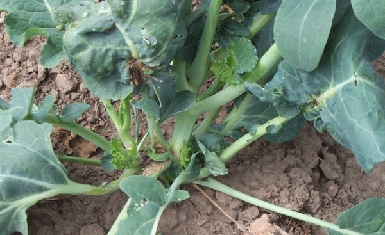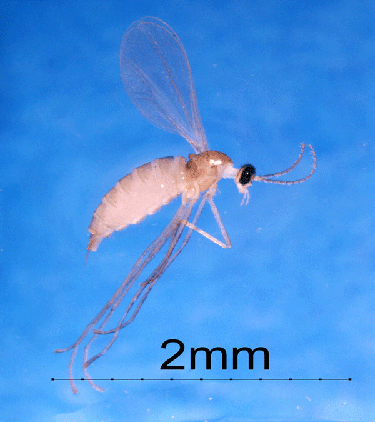Introduction
The Swede midge (Contarinia nasturtii), an invasive agricultural pest (also known as the cabbage crowngall fly and cabbage gall midge) was first detected in New York in 2004 in Niagara County. Although the insect is a native of Europe and southwestern Asia, it is believed the midge was introduced into NY from the Canadian province of Ontario where it was first found on broccoli in 1996. By the end of 2007, the Swede midge had been confirmed in 12 NY counties (Allegany, Chenango, Franklin, Herkimer, Jefferson, Livingston, Onondaga, Otsego, Rensselaer, Steuben, Suffolk, and Yates).
Biology
This species is a small (1.5 – 2 mm), light brown fly that is indistinguishable from many other midges except by an expert entomologist. Adult midges emerge in the spring from pupae that have over-wintered in the soil. Adult flies mate soon after and females search for suitable host plants. Each female can lay about 100 eggs during their one to five day lifespan. The females lay their eggs on the growing point of young plants. Larvae hatch from the eggs after a few days and begin to feed in groups on the growing plant tissue. Larvae complete their development in 7 – 21 days after which they drop to the ground and pupate in the soil. Adults can emerge within two weeks, restarting the cycle. Depending on temperature and length of growing season, there can be up to five overlapping generations of Swede midge per year.
Damage
As they feed, Swede midge larvae produce a secretion that breaks down the surface of the growing point of the plant and liquefies the cell contents, resulting the formation of leaf and flower galls and a misshapen growing point. Damage caused by Swede midge larvae feeding results in distorted growing tips and may produce multiple (or no) growing tips; young leaves may become swollen or crumpled and leaf petioles or stems may exhibit brown scarring. Swede midges feed only on cruciferous vegetable crops, such as cabbage, cauliflower, broccoli, and Brussels sprouts, frequently causing severe losses. The insect also damages canola, collard, horseradish, kale, mustard, rutabaga, turnip, and radish.

Management
Insecticides can be used to kill adults or prevent them from laying viable eggs. However, controlling larvae is much more difficult because insecticide would have to enter the plant tissue upon which the larvae are feeding. Currently, the best way to manage Swede midge damage is to limit the spread of the insect into new areas. Adults are very weak fliers, so the primary vector of introduction is believed to be the movement of transplants which may contain eggs or larvae, or movement of soil which may contain pupae. Repeated working of infested soil can reduce the number of viable pupae. Also, because adult Swede midges cannot travel far, crop rotation using noncruciferous plants can help to reduce the likelihood of spreading an infestation.




